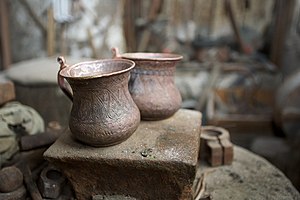| Revision as of 00:25, 6 November 2014 editPigsonthewing (talk | contribs)Autopatrolled, Event coordinators, Extended confirmed users, Page movers, File movers, IP block exemptions, New page reviewers, Pending changes reviewers, Rollbackers, Template editors266,349 edits bad merge← Previous edit | Revision as of 00:25, 6 November 2014 edit undoPigsonthewing (talk | contribs)Autopatrolled, Event coordinators, Extended confirmed users, Page movers, File movers, IP block exemptions, New page reviewers, Pending changes reviewers, Rollbackers, Template editors266,349 edits Added {{merge to}} tag to article (TW)Next edit → | ||
| Line 1: | Line 1: | ||
| {{merge to|Paisley (design)|date=November 2014}} | |||
| ] | ] | ||
| '''Buta''' ({{lang-az|Buta}}) – is an almond-shaped ornament with a sharp-curved upper end.<ref name="Эрмитаж"/> Buta motif belongs to ]. It is broadly famed in ], ] and countries of the ].<ref name="Эрмитаж"/> | '''Buta''' ({{lang-az|Buta}}) – is an almond-shaped ornament with a sharp-curved upper end.<ref name="Эрмитаж"/> Buta motif belongs to ]. It is broadly famed in ], ] and countries of the ].<ref name="Эрмитаж"/> | ||
Revision as of 00:25, 6 November 2014
| It has been suggested that this article be merged into Paisley (design). (Discuss) Proposed since November 2014. |

Buta (Template:Lang-az) – is an almond-shaped ornament with a sharp-curved upper end. Buta motif belongs to Azerbaijani culture. It is broadly famed in Azerbaijan, Turkey and countries of the Near East.
Patterns and ornaments of buta motifs can be met on Azerbaijani rugs, kalaghai and textiles, paintings of decorative-applied arts of Azerbaijan and also in decorations of architectural monuments.
Buta in Azerbaijani culture
“Buta” is a typical detail of Azerbaijani national ornaments. This motif is considered as the most ancient among all national ornaments of Azerbaijan. There are many printed items decorated only with buta. Buta motif was frequently used by Azerbaijani masters. Buta has a lot species and each of them has its own symbolical meaning. But buta is widely spread in Ganja, where it has become an integral part of carpet ornaments.
Buta is displayed in the emblem of the 2012 FIFA U-17 Women's World Cup, which has been held in Azerbaijan.
Gallery
References
- ^ Н. Самгнна. (1995). Ковры типа Фахралы. Vol. 56. Сообщения Государственного Эрмитажа: Искусство. p. 59.
- В. Лобачев. (1975). Магия подзаголовка. Книга. p. 190.
- ^ Г. А. Гулиев. (1964). Об азербайджанской набойке. Советская этнография: Издательство Академии наук. p. 134.
Sources
- F. Petri «Origin of the Book of the Dead Angient Egipt». 1926. june part 2 с 41-45
- С. Ашурбейли «Новые изыскания по истории Баку и Девичьей башни» Альманах искусств 1972 г, С.Ашурбейли «О датировке и назначении Гыз галасы в крепости» Элм. 1974 г.

